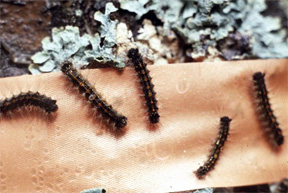Forest tent caterpillars and gypsy moths are feeding on trees
Editor’s note: This article is from the archives of the MSU Crop Advisory Team Alerts. Check the label of any pesticide referenced to ensure your use is included.
Forest tent caterpillar outbreak is in full swing
Blocks of state and national forest are being completely stripped by forest tent caterpillar in the northern Lower and Upper Peninsulas. The caterpillar can be also found in the southern Lower Peninsula as well, but heavy defoliation is more unusual. Oak and aspen forests and woodlots are being hit the hardest, but many other hardwood species are also being stripped, especially when mixed in with oak or aspen.
The caterpillars are about done feeding for the year in southern Michigan and are wandering about and pupating. For more information on forest tent caterpillar, see: http://www.na.fs.fed.us/spfo/pubs/fidls/ftc/tentcat.htm
Gypsy moth defoliation becoming noticeable in some places
Gypsy moth caterpillars are now a half-inch long or larger in southern Michigan and feeding damage is becoming apparent in infested woodlots. Oaks, poplars and birch are their favorite forest trees, but gypsy moth may feed on quite a few other hardwood species as well. The outbreaks are localized and scattered throughout the state, so you could see some gypsy moth damage just about anywhere.
The fungal pathogen, Entomophaga maimaiga, was very active last year, and is expected to take a heavy toll on gypsy moth caterpillars again this year, reducing the severity and length of outbreaks. Outbreaks can last one to three years.
Caterpillars defoliating linden trees in some Clinton County woodlots
In addition to forest tent caterpillar and gypsy moth, we are seeing some cankerworms or loopers, smooth-skinned caterpillars that ‘inch’ or ‘loop’ when they walk. These caterpillars are defoliating linden (basswood or Tilia) trees in Clinton County.
Will forest tent caterpillar or gypsy moth defoliation kill my tree?
Not usually. If less than half of the leaf canopy is consumed, it will have a minimal impact on tree health. More than 50 percent defoliation can be stressful, and more than 80 percent usually results in the tree pushing out a new set of leaves in July, a very stressful event, because much of the trees starch reserves are consumed in the process. The impact of defoliation also depends on tree health and site conditions, but you can use the following information as a general guide:
| Amount of spring defoliation | Impact on shade trees |
| Less than 30 | None |
| 30-50% | Minor stress, a little branch dieback may be visible the following spring. |
| 50-75% | Stressful and likely to cause some branch dieback the following spring. Most trees will return to a healthy state in time. |
| 75-100% | Very stressful, 5-10% of the defoliated trees may die. Survivors may be weakened and branch dieback will be obvious the next spring. |
| 100% two years in a row | May cause extensive tree mortality, especially under droughty conditions. |
Defoliation in late summer or early fall is not as harmful and rarely causes dieback or tree mortality. Also, if shade trees in your yard are defoliated in late June or early July, water the trees when the soil is dry to help them push-out a new set of leaves.

Young gypsy moth larvae (1/2 - inch long).
Dr. Smitley's work is funded in part by MSU's AgBioResearch.



 Print
Print Email
Email




